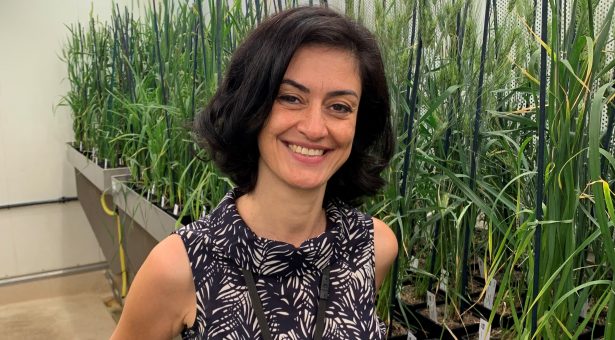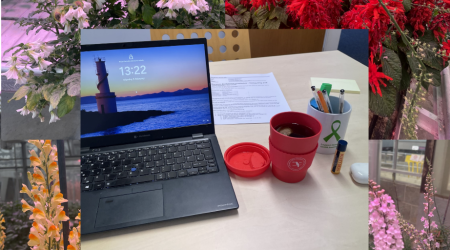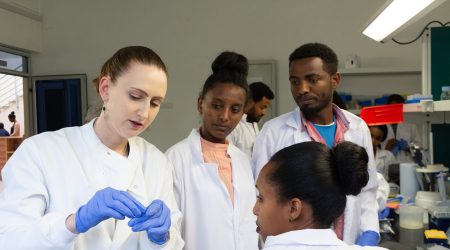Diversity in science, genome editing and transformation; Introducing Sadiye Hayta

Dr Sadiye Hayta is a Senior Scientist and the lead scientist of wheat transformation and genome editing here at the John Innes Centre . She is a member of the Race and Ethnicity Equality and Diversity working group (REED) which aims to raise awareness of race and ethnic equality and diversity.
We spoke to Sadiye about how she became a scientist, her current research, and the work of the REED group.
“As a youngster I had broad interests, including nature and biology. However, my main interest was art, then nature, and in third place was literature.
My mother wanted me to go into medicine, my father wanted me to go into academia. In both sides of the family there are both medics and academics. However, for me, biology won in the end, and I got into the top university in Turkey for the subject.
After I got my biology degree, I was asked if I would consider doing an masters degree (MSc) at the university that I graduated from. I wasn’t sure what to do at that stage, and I knew how difficult it would be from some of my friends’ experiences.
In the end, I didn’t take the offer of doing a masters for the simple reason that it was in another city from my family. Instead, I applied for a masters at a completely new university in my home city, Izmir in Turkey on the Aegean coast.
Later that year I started studying for a master’s degree in plant biotechnology in the Bioengineering department at the Aegean (Ege) University, in Turkey.
After gaining my masters, I started my PhD in bioengineering, focusing on secondary metabolites and their production in bioreactors for medicinal use. A PhD in Turkey takes on average five years to complete, and usually involves a number of side projects as well as the main project. Because of this I had some very good collaborations with other research institutes and industry during this time.
In Turkey, it is expected that PhD students look after and supervise undergraduate and master’s students including giving lectures. From the very beginning of my PhD, I was always helping students and I found this to be one of the most rewarding parts of working at the university.
After my PhD, I worked as a Postdoctoral Researcher, and this led to an indefinite position with one of the prestigious universities in Turkey. I planned to become an Assistant Professor, and one of the stipulations for such a position is to spend time working abroad.
At this time, I was also writing a new grant to start my own research.
I came to the John Innes Centre as a visiting scientist with a fellowship working in the Crop Transformation facility in 2011 between my Postdoctoral position and the new Assistant Professor position to learn some new techniques and find new collaborations to include in my future research.
My first task was to develop an Agrobacterium based wheat transformation system. It was initially only for six months, but I extended this visit to one year, and then I returned to Turkey for nine months.
During this year, I was impressed by the science at the John Innes Centre, and I returned as a Senior Postdoctoral Researcher. This new position working within Professor Phil Gilmartin’s group on heterostyly in Primula was a completely new project and area of research for me.
To be able to bring cutting-edge understanding and technology to a scientific conundrum that had been puzzling scientists since before Darwin’s observations was a wonderful experience. I developed the first ever transformation system for Primula, in Primula vulgaris to enable the understanding of the genes responsible for floral heteromorphy, the main focus of the Gilmartin group’s research.
During this time, I had the chance to work on wheat transformation and genome editing again, while completing the work on Primula. From this starting point, I have developed an efficient and robust Agrobacterium-mediated transformation method in wheat.
I now lead the transformation and genome editing of wheat at the John Innes Centre within the Crop Transformation platform. This role involves collaborations on many different projects, with both internal groups at Norwich Research Park and external institutes and universities.
I really love the idea that our work here at the John Innes Centre has the potential to reach and benefit many different people worldwide. I believe we can make a positive impact working together, openly and collaboratively, and plan to continue my career here at the John Innes Centre.
I am very proud to be part of the Women in Wheat programme which supports women to progress to senior academic positions in wheat research. I feel, I have gained a lot from the training and mentoring the programme provides.
My focus now is to develop innovative strategies in genome editing that I can adapt and improve for wheat transformation and genome editing technologies.
I find the John Innes Centre an inspiring place to work. Almost all the researchers here have some international experience, and everyone accepts and celebrates diversity. I think having this diverse environment adds richness to the John Innes Centre and makes it a unique workplace.
A lot of people speak English as a second language which makes you feel comfortable. People are open and happy to share their knowledge and exchange ideas. It is great to have a wide-ranging research environment, where you can always find someone with experience in the topic that you are interested in.
I am proud to be part of the Race & Ethnicity, Equality & Diversity group. I believe as a member of a minority group, and having gone through similar experiences to others is useful to highlight problems and it is good to feel that I am contributing to solutions.
In the REED group we are working on how we can embrace and welcome new staff and students from different countries, backgrounds, orientations and make them feel they are part of our inclusive working environment.
There is good ethnic diversity at early career stages in science but unfortunately, there is a bottleneck moving through the career pipeline, as a result there is currently a lack of ethnically diverse role models at a higher level, both here at the John Innes Centre and more widely. I am passionate about addressing this and am delighted to be working with enthusiastic colleagues here to continue to make positive change happen.
The REED group, together with the John Innes Centre more widely, is working to address this bottleneck. One way we are addressing the problems is looking for ways to prevent unconscious discrimination. Unconscious bias refers to the deep-seated prejudices absorbed due to living in unequal societies. I think raising awareness of unconscious bias and celebrating the differences of all of us is very important.
It was encouraging to see that diversity is included as a key principle for change in UKRI’s recent strategy, and I look forward to seeing the as yet unpublished UKRI EDI strategy which the REED group fed into via the John Innes Centre’s Inclusivity and Diversity committee. These are both great steps in the right direction for the wider community.
I believe communicating to a wider audience is a good way to attract people from different diverse and ethnic groups. If we can showcase and celebrate the successes of people from different backgrounds, and share their experiences, we can help attract the best people without limitations though background or diversity.
The REED group has already implemented changes and new initiatives, which I find really exciting, and I can’t wait to contribute to this. I hope that by working to creating a culture that supports diversity we can enrich the research atmosphere at the institute, provide visible role models and to support each other into the future.



